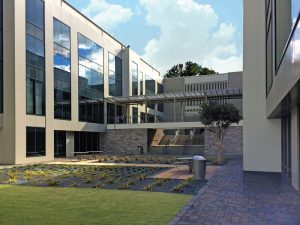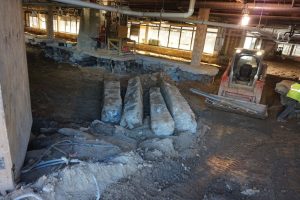Throughout the ages, humanity has been warned – do not build on weak foundations. Even the “Good Book” uses a parable of a home built on sand to emphasize the importance of a solid foundation in life.
However, the wise sages of the past did not live in today’s fast-paced world. As hard as most members of today’s society try to be good stewards of the land, some things get pushed to the wayside… literally.
As our superhighways were under construction following President Eisenhower’s Highway Act, all manner of materials were generated as waste. This waste was often pushed to the side in a landfill. Moreover, being adjacent to a major interstate, that landfill, in turn, became prime real estate.
That is the background of Atlanta’s Northwest Medical Office Building (MOB) and parking deck. This state-of-the-art structure was built in the 1970s on fill containing organic materials and construction debris such as stone, brick, and concrete. The location was originally a dumping area for waste generated from constructing I-75 adjacent to the building site.
With that background, on to the problems – and there were many. The first floor of the parking deck, the service drive, and the terrace area between the parking lot and the MOB were built to bear on construction fill. The MOB was constructed using post-tensioned slab bearing on caissons. Over the years, the first-floor parking deck began to settle unevenly, requiring continuous remedial work. It was jokingly described as having a roller coaster effect. The soils throughout the site were in deplorable condition, and the cavities under the slab-on-grade were far worse than expected.
With the major problems for the parking deck identified, the owner faced the fact that the MOB desperately needed to update the facility if they planned to keep their existing tenants and attract new ones. The lobbies needed updating, the building needed to be re-skinned, and the settlement needed to be corrected on the sidewalks and surrounding driveways.
If this facility was to be saved, it was time for some desperate measures. The design team of Sedki & Russ Structural Engineers, MSTSD Architects, and New South Construction was tasked to provide structural solutions.
The first problem addressed was that the slab-on-grade at the parking deck was not structural and rested on top of the construction fill. Through the years, the slab kept settling and the owner kept adding more concrete to level it. This, in turn, required additional ramps and stairs which may have compounded the issue by adding more weight and increasing the potential for further settlement. Consequently, the only solution left was to remove the slab and replace it with a structural slab bearing on a deep foundation.
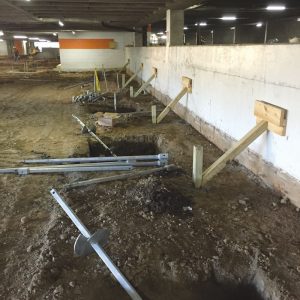
The kickers holding the side form of the slab during the pouring of concrete, and also showing the holes where the helical piers are located. Courtesy of MSTSD Architects.
The challenge was for the design team to develop a system that was economical, practical, and environmentally friendly. Several repair systems were considered, including auger cast piles, driven piles, and caissons. However, the cost of these methods was over budget and required removal of contaminated soil, exposing methane gas or causing excessive vibration to the structural frame during removal. The system that met all the requirements was to use helical piers with an allowable capacity of 40 kips and place a two-way reinforced concrete slab on top. The pier spacing varied to limit the total load on any pier to the 40-kip capacity. The slab at the parking area was designed for a live load of 40 psf and the driveway to meet HSS15 highway loading.
During the removal of the existing slab-on-grade, the clearances in the garage created two significant issues. First, there was not enough head height to use traditional equipment for installing the new piers and, second, there was not enough room to use traditional equipment for the slab removal. Thanks to the creativity of New South Construction Company, a small bobcat was rigged for the pier installation and a plow was welded to a bobcat to help break and remove the slab.
During the installation of the piers, an additional issue emerged – very few piers were able to be placed in their designated locations due to obstacles in the soil below. Thus, the structural slab was continually in redesign to accommodate the new pier locations and to avoid any delay in the construction schedule.
The second challenge that the design team faced on the NW Medical project involved the terrace level between the two buildings and the driveway connecting the buildings and the parking deck. The same issue with obstacles was encountered, but headroom was not a problem and removal of the slab was not complicated.
In this location, however, new storm and sanitary lines had to be placed deep below the slab. These lines cannot tolerate settlement and thus had to be supported by structures bearing on a deep foundation as well. Helical piers were installed with a continuous concrete pad on which these lines rested. Additionally, transformer pads and dumpster pads could not be removed and replaced; therefore, supports were added in these areas before the placement of the new slab.
At the existing terrace level at both buildings, the original structure was slab, beams, and girders. However, a few years after its initial occupancy, this slab was removed and replaced with an 8-inch post-tensioned (PT) flat plate. At a few locations such as the perimeter girders, stair slabs and the mechanical floor of the original construction remained. The new slab had been attached to those existing elements. The post-tensioned slab was performing well, but due to the low floor-to-floor height, the owner elected to remove the PT-slab and place a new, reinforced concrete slab bearing on helical piers and the existing caissons, to provide an additional 16 inches of headroom.
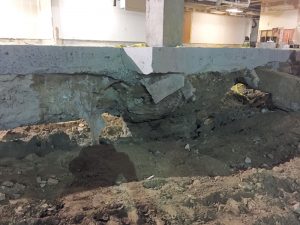
Grade between columns and the overpour at each column base below the PT Slab. Courtesy of New South Construction.
The slab at the terrace level had settled, in some areas close to ten feet. This complicated the removal of the post-tensioned slab, where the slightest error could result in catastrophe. For instance, cutting the wrong cable could result in a slab failure, or projectiles of spalled concrete or actual tendons could cut through walls.
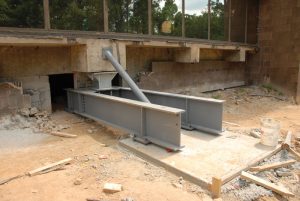
The steel frame before it was in place, designed by Sedki & Russ Engineers to pick up the four-story columns. Courtesy of MSTSD Architects.
The next challenge encountered at the terrace level was that the owners wanted the slab to be removed in the areas the previous renovation had avoided. In these areas, the girders-on-grade were cantilevered beyond the caissons below and supporting four-story columns. To remove these girders would cause the columns to lose their support completely. Sedki & Russ Structural Engineers detailed a steel support outside the building, bearing on the existing caissons and on helical piers having a new concrete cap. This system would support the columns once the slab and girder were removed. The steel frame was encased in concrete and placed below finish grade.
Working on a project of this nature with so many unknowns, challenges are many and require quick decision-making and resolution, like redesigning the slab and beams or changes to the architectural design. In the end, the challenges were met, and the structure was successfully completed.
For a project like this, one is reminded of Longfellow’s lines, “Ah, to build, to build! That is the noblest art of all the arts.”▪

